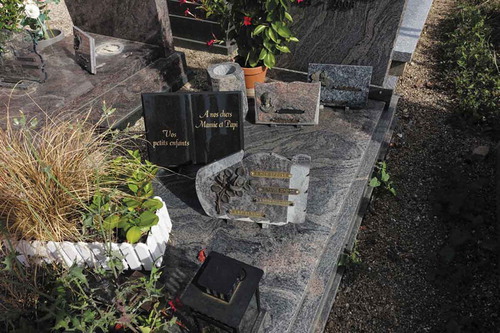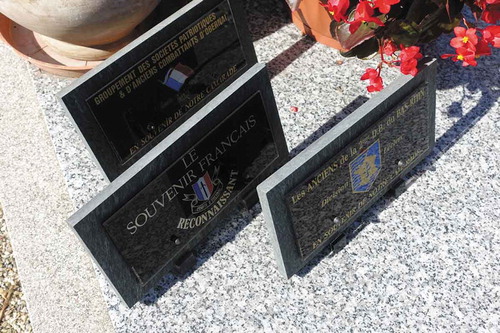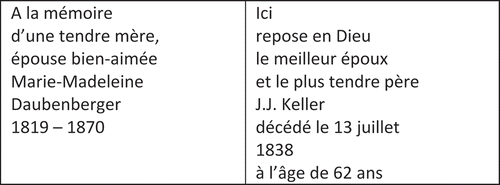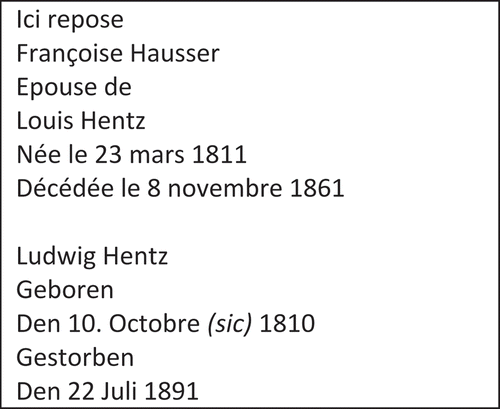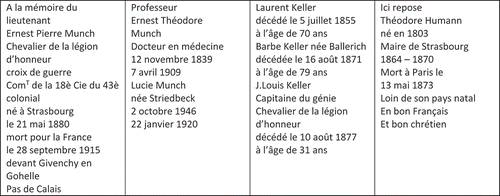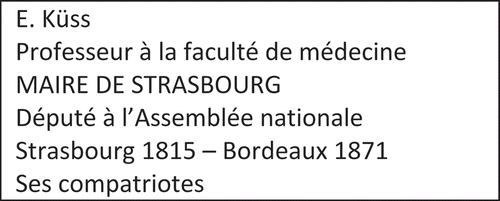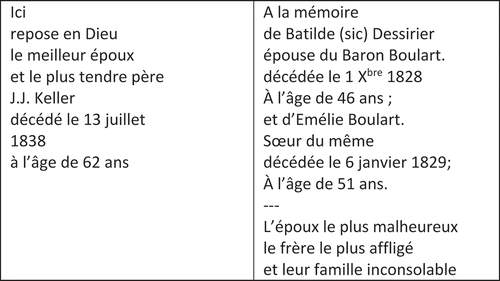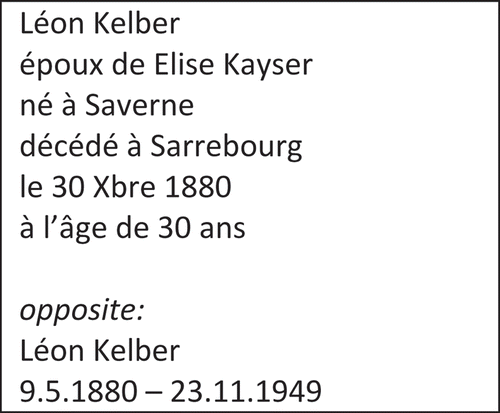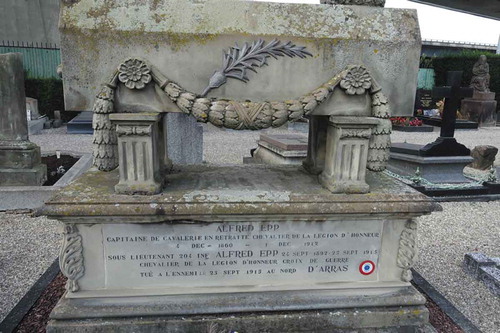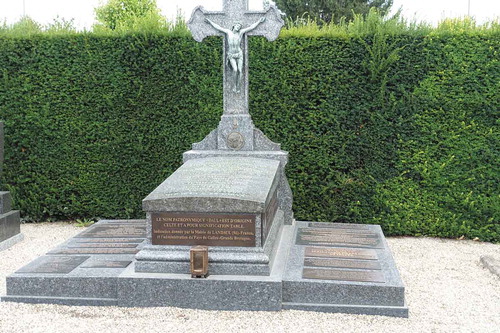ABSTRACT
The French region of Alsace has a strong Germanic tradition, in having shifted four times between France and Germany between 1870 and 1945. Hence, the question of regional and national identity is a recurring one in Alsatian cemeteries, which reflect changing identities in several ways. Starting out from the epitaphs and more precisely the names that are inscribed on the gravestones, the language chosen and the life narratives that are told, this study examines how Alsatian cemeteries express messages of identity intended to last, and also how they contribute to the construction of regional and national identities. Furthermore, the materiality of the tomb is taken into consideration. In sum, the study testifies to how identity operates beyond death. It shows how the Alsatian graves and their cemeteries are endowed with an agency on their own, making cemeteries participate to the construction of regional and national identity.
Introduction
In Alsace, as in many other places, epitaphs on tombstones tell us about relationships, history, ideologies, and life narratives, retaining them for decades to come if not for centuries. What is written on a gravestone is inscribed there for several reasons and usually follows a predictable grammar (Mytum, Citation1994, p. 255), a recurrent pattern. The engraved name constitutes the core element, frequently together with the relevant dates of birth and death. Identity may however be expressed in many ways: by the grave itself and its materiality, or in the text inscribed on it, or even by the absence of explanatory text. The graves and the epitaphs form common ways of presenting the dead and are, therefore, subject to many conventions. The name and lifespan are crucial, first of all, since they enable the identification of a specific tomb. Names and dates may then be complemented by other components, for example ritual phrases such as ‘Here rests … ’, locations, biblical quotes, photos etc. Family, friends and others may contribute to the text by placing commemorative plaques on the tomb. Taken together, these elements constitute the span of features regarding asserted identities, and the full range is studied here in order to examine identities constructed in Alsatian cemeteries.
Some of these traces we might find in any graveyard, for example information about profession or kinship. But since the national belongings of Alsace have shifted, we can also expect to discover traces of identities pertaining to episodes concerning the history of this border region that has switched several times from France to Germany and back again. Indeed, the Germanic region of Alsace became French in the 17th century and remained so until 1871 when it reverted to German rule after the peace treaty of Frankfurt, which established a new border between France and Germany. In 1918, after the end of World War I, the treaty of Versailles modified the border once again and granted Alsace back to France. In 1940, Germany claimed Alsace back, and the province became French again only by the end of World War II. With each political swerve, the Alsatians were either attributed a new nationality or, if they refused to accept this, were compelled to leave the region. They also had to switch their language from French to German, or the reverse, depending on which nation ruled at the moment. Subsequently, these changes have left traces of many different kinds, not least evident in the cemeteries.
A gravestone is designed for the public: visitors who would like to see where a relative has been granted a final rest, mourners, or mere passers-by. In that sense, gravestones form acts of communication and social actions ‘mediated by a confluence of discourses that may include historically situated local and national language ideologies, beliefs about the individuals intended to view public signage, and (dominant) expectations about language functions that contribute to producing the linguistic landscape’ (Hult, Citation2014, p. 510). The departed may in turn be described and identified by different characteristics, such as having been a good mother or a beloved husband, by his or her occupation or place in society. The tomb itself, with its materiality, its location, its size, may also signal an element of identity; it provides information about the departed and the community of which they were part, not least through the identifiers that are displayed on the grave.
Cemeteries mirror the real world of the living and grave inscriptions illustrate ‘the values, attitudes, and social thought at a given point in time’ (Anderson, Sielski, Miles, & Dunfee, Citation2011, p. 359). ‘The graveyard becomes a metaphor of life’, Guthke comments (Citation2003, p. 59), and Sautkin states: ‘It goes without saying that cemeteries reflect the identities of people buried there, the statuses and roles of their social life. In this aspect, cemeteries can be a source of reconstruction of the social structure, social hierarchies, and the identity contours of a particular community associated with a particular cemetery’ (Citation2016, p. 662). Tombstones for their part carry symbols and traces of social status, family ties, wars, migration and much more, and constitute a text where we find life narratives. Bruner observes that ‘narrative imitates life, life imitates narrative’ (Citation2004, p. 692): ‘In the end, we become the autobiographical narratives by which we “tell about” our lives […] we also become variants of the culture’s canonical forms’ (Citation2004, p. 694).
The cemetery will here be seen as a text which produces meanings and furthers a discourse that can be read and interpreted by visitors, and also affect and influence them. These meanings are not always innocuous, and Bellanger and Tartakowsky (Citation2011, p. 11) observe that cemeteries also form political constructions where there is a lot at stake. The same is likely to be true for the graves we look at today in Alsatian cemeteries. We thus have to deal with different levels of identity: an individual level and a collective level, which both may be traced in the cemeteries examined for the purpose of the present study. A starting point of the investigation is that ‘identity is the set of meanings that define who one is when one is an occupant of a particular role in society, a member of a particular group, or claims particular characteristics that identify him or her as a unique person’ (Burke & Stets, Citation2009, p. 3).
This study aims to describe how messages in Alsatian cemeteries mirror such sets of meanings. Which identities are considered essential to inscribe on a grave and intended to remain beyond the death of the person? And how can inscribed messages and meanings have an impact beyond the identity of the individual, at a regional or national level, then gaining an agency on their own? To do this, I will first provide a general background, mainly with regard to cemeteries and identity, and a brief description of the methodological choices that were necessary. Then, I will illustrate how different identities are displayed through identifiers on the individual graves, i.e. through the name and other given personal characteristics, linguistic choices and life narratives. Before concluding, the example of a specific family tomb will illustrate and bring together the various aspects that have been examined.
Background
Cemeteries and graveyards (the two words are here used as synonyms) are closely connected to a specific place, whether in a village or a town. They are a public or semi-public space, usually open to anybody during long hours of the day, and clearly delimited not only by a fence, a wall or other demarcation (Vajta, Citation2018, p. 138–140), but also by the nature of the signs themselves (Blommaert, Citation2013, p. 15), since tombs and inscriptions like epitaphs will not be found outside of the cemetery. Those buried there can often be expected to have a story relating to that particular place, whether as a place of residence or what is casually called ‘roots’ or ‘identity’. McClymont (Citation2016, p. 385) states that cemeteries form ‘an intrinsic part of place identity’ and that they ‘have a role in promoting civic identity and local place attachment’. It is generally recognised that cemeteries and grave inscriptions not only mirror the surrounding society with its history and its distinctive features but also assert, corroborate and construct identity. Kotilainen (Citation2013, p. 176) observes that ‘reading the texts on all the gravestones and crosses in the graveyard(s) of a single parish provide us with a miniature collective biography representing of the inhabitants of the whole parish.’ Furthermore, Anderson et al. (Citation2011, p. 359–360), with reference to Guthke (Citation2003), observe that ‘grave inscriptions serve as a “cultural memory”, illustrating the values, attitudes, and social thought at a given point in time.’ Referring to Foucault, who considers the cemetery as a ‘strange heterotopia [that] certainly [is] a place unlike ordinary cultural spaces’ (Foucault, Citation1986, p. 25), Wright argues that the cemetery is to be seen as ‘a particularly important rhetorical memory space’ (Citation2005, p. 52) and ‘a sacred space that produces meaning […] a heterotopia, and a place that represents, contests, and inverts’ (Citation2005, p. 54). In fact, to Wright the cemetery has a memory which is ‘like the mirror and its reflection: real because of the physicality of the grave yet unreal and easy to distort’ (Citation2005, p. 55). Since the cemetery is a heterotopia the identities displayed are not an exact reflection of its surrounding society. Sautkin (Citation2016, p. 662) explains that ‘it goes without saying that cemeteries reflect the identities of people buried there, the statuses and roles of their social life […] However, it should be taken into account that society constructs a special status of “the deceased”, which is not determined by the social status of individuals within their lifetime.’
When studying Roman funerary monuments, Hope has found that ‘deciphering the messages reveals significant insights into how people perceived themselves, their own identities and their relative position and role within Roman society’ (Citation1997, p. 199). Reimers (Citation1999) in turn, who studied gravestones in Sweden, observes that ‘gravestones serve as tools for presentation of self and identity. Through choice of language for the inscription and symbols on the stone, the deceased becomes anchored in a particular ethnic or cultural context. […] the grave […] becomes part of an identity construction’. In Alsace, the choice of language in general, and on gravestones in particular, can be considered as an identity statement and epitaphs tend to mirror the ongoing language shift from German to French (Vajta, Citation2018).
I see the cemetery as a place of ‘cultural memory’ (Guthke, Citation2003), a linguistic landscape. As such the cemetery ‘serves two basic functions: an informational function and a symbolic function’ (Landry & Bourhis, Citation1997, p. 25), while also referring to ‘any display of written language’ (Gorter, Citation2013, p. 190). The cemetery will be considered as both a verbal and non-verbal text, one that reveals identities by indicating social status and roles, expresses ideologies, states language choices, and refers to relationships or historical events. All these features serve to identify, both at an individual and collective level, in the different usages of the verb: identify with, be identified as, or identify as.
It may be interesting to discuss not only what is stated on the grave, but also how it is stated, what the intention might be and what is omitted. A memorial monument like a tomb is inevitably part of a landscape and of a space – the cemetery – where the ‘intended messages are conveyed through multiple information design modes, including language, materiality and emplacement’ (Huebner & Phoocharoensil, Citation2017, p. 107). Commemorative plaques from family members, colleagues and friends are also to be taken into account. These plaques are placed on the grave and about the size of some twenty by thirty or forty centimetres. The messages inscribed can be a personal greeting from a relative or a standard message consisting of a verse or a poem.
Furthermore, the grave may provide a description of the personality of the deceased, constructing the image of their identity in the way the family or the community would like to remember them, sometimes literally by showing a photo of the departed, mostly at a younger age. Then, the question of agency must be raised: Who is the agent behind the gravestone and what can be inferred about the intention behind its construction and inscription? What agentic capacity does the gravestone in turn perform on the visitors to the cemetery, immediately and in the long term? Precise agency is often hard to ascertain when it comes to gravestones, even if it is generally the family or those who were close to the departed who have decided on the design (Vajta, Citation2018, p. 139–140), which symbols will be displayed and what will be inscribed on it. Thereby they put the identity of the departed into a position within ‘the set of meanings that must be maintained’ (Burke & Stets, Citation2009, p. 16). But it sometimes happens that agency is made abundantly clear; that the inscription for example includes a message from a son, a spouse, or other members of the community to which the deceased belonged. Burke and Stets explain that ‘each person has many identities, for example, friend, parent, worker, church member and club member; and each of the identities is an agent’ (Citation2009, p. 8). Agency can then be discussed in two senses: on the one hand the agency of those who actually and tangibly composed the graves or the commemorative plaques, and on the other hand the agency of the graves themselves, starting out from the meanings that are intended to last and to survive beyond the death of the individual.
Burke and Stets (Citation2009, p. 3), state that an ‘identity is the set of meanings that define who one is when one is an occupant of a particular role in society, a member of a particular group, or claims particular characteristics that identify him or her as a unique person.’ Hence, I will examine what set of meanings are expressed on the gravestones in the cemetery, or, to put it in other words, what identifiers (or descriptors) we can find on them and how they may work together. Building on what Burke and Stets regard as the bases of identities, and more precisely on the distinction they make between person identities and social identities, I will here understand person identity as what allows one to identify a person and differentiate them from others. In the words of Burke and Stets, it is ‘the set of meanings that define the person as a unique individual rather than as role-holder or group member’ (Citation2009, p. 124). To the person identity will then be brought the mentioning on a headstone of a person’s qualities, of a profession, of family ties or of some other features that are perceived as distinct for a specific individual. In turn, social identity entails ‘being like others in the group and seeing things from the group’s perspective’ (Citation2009, p. 118). Social identity will here be understood in a broad sense, as the spectrum of a person’s roles within a community, for example military or political ones, and what these might entail. Altogether, we can expect these different utterances of person identity and social identity to provide a mirror of Alsatian society, telling us which messages and meanings were essential to enunciate on a grave and to remain after death.
Methodological choices
The linguistic landscape of the cemetery is constructed not only in synchrony, but also very much in diachrony – often over decades, if not centuries. Sources of error are multiple: not all graves are preserved through time in a way that grants an analysis. Graves can be reused, renovated or replaced, in which case their text may have been altered. Neither is it always obvious that the headstone dates from the time of the relevant individual’s death, especially if the grave holds several persons. Furthermore, stones weather, inscriptions erode and are overrun with ivy or hidden by cypresses; statues and plaques fall down. This explains why the study of historical linguistic landscapes ‘must make do with what is left’ (Coulmas, Citation2009, p. 15) and I cannot but agree with Kotilainen when she comments that the ‘quality of [her] research data is indeed totally dependent on what monuments happened to have been preserved at the graves’ (Citation2011, p. 176). All this makes any quantitative analysis irrelevant and explains why a qualitative approach appeared as a more fruitful procedure. Consequently, the examples provided are chosen because they illustrate an element of identity and bring forward more general features observable also on other tombs and in other Alsatian cemeteries. The methodology falls within the framework of an inductive qualitative analysis ‘within an expanded view’ (Waksman & Shohamy, Citation2010, p. 63). Building on Gee’s notion of situated meaning (Citation2014, p. 157–161) I ask what messages the inscriptions in cemetery carry. Written verbal text will be complemented by non-verbal texts, such as icons and images, following a multimodal approach (Kress, Citation2010; Scollon & Wong Scollon, Citation2003).
After having visited fifteen cemeteries, three were selected for a closer examination of the disclosed identities on the gravestones: one in Saverne and one in Obernai, two small towns with around 11000 inhabitants, as well as one in Strasbourg, the capital of the region. All three towns are located in the department of the Bas-Rhin, in the Northern part of Alsace. Saverne and Obernai were chosen because of how they encompass characteristics that can be observed also in other towns and villages in the region. The cemetery in Strasbourg was selected on the same basis, and also because it belongs to a big city and the fact that quite a few eminent families and personalities are buried there. All three harbour significant features that are not exceptional in any way and that can be regarded as generally occurring in the graveyards of the region. The graves were photographed, verbal and iconic texts were recorded. Affiliated commemorative plaques were also photographed, in order to complement the material with other commenting texts. In all, more than 500 photos were taken, each image mostly showing several elements and inscriptions for several persons.
In order to study the identities displayed, and drawing on previous research (Vajta, Citation2018), I determined to focus on identifiers that could be found on any tomb. These identifiers emerged from an inductive, qualitative content analysis of the material, a process that ‘often begins during the early stages of data collection’, as Zhang and Wildemuth (Citation2009, p. 2) point out. This entailed recursively and systematically going back to the material and thoroughly working through it, thus allowing a process of meaning-making (Willig Citation2014) and a comprehensive study of the identifiers. The following identifiers were decided on: firstly names (and other individual characteristics or personal descriptions), then language choice for the written text, and finally life narratives. These are recurring elements on many graves, though not all: one grave may display all of these identifiers, another none of them, and a third one or two. Taken together the selected identifiers can be expected to build identities (Gee, Citation2014, p. 116) and to cover the different bases of identities as seen by Burke and Stets (Citation2009, p. 112–129): role, group and person, but without aspiring to do so in an exhaustive way.
Names and personal identifications
In the graveyard, a very important informational element is indeed the name given on tombs. As Edelman (Citation2009, p. 143) observes, names ‘distinguish individuals from each other; they identify someone or something’. The name inscribed on a grave is a person’s most obvious identifier and performs an informational role in the linguistic landscape. Kotilainen (Citation2013, p. 62) points out that the personal name allows for the identification of a person and often also a family affiliation. She notes that ‘naming reveals how the people followed the fashions of the times, what name-givers at a particular age valued and how they reacted to events in the outside world’ (Citation2011, p. 50). She adds that ‘personal names could create intangible symbolic capital’ (Citation2011, p. 54), the connotation of a specific name being sometimes endowed with more prestige.
Many tombs, especially more recent ones, only carry an inscription like ‘Famille Kastler’, ‘Famille Schmitt’ or ‘Famille Leibel’. But it seems as if such a collective family belonging of the dead is not always satisfactory. Many times, commemorative plaques () have been placed on the grave, specifying the names of the person(s) who rest(s) in the tomb. These commemorative plaques are rather frequent and usually describe a relationship (‘À notre ami’, ‘À notre sœur’), expressing feelings of loss or promising eternal remembrance (‘À mon épouse. Je ne t’oublierai jamais’, ‘Dans notre cœur à jamais tu demeures’). Even if most of them do not include any names but are ready-made with standard phrases, they obviously relate to the name on the headstone. The agent having placed a plaque is likely to be identified by the closest family, e.g. through the relationship stated on it. The intention is clearly to express a feeling of grief and sorrow. Another example can be seen in former comrades-in-arms, who often leave plaques specifying in which division they fought together during a war (). The texts can also be more descriptive thus constructing and verifying the identity of the deceased: ‘For every role that is played out in a situation, there is a counterrole to which it is related’ (Burke & Stets, Citation2009, p. 115). The role of father has a counterrole related to a child, the role of husband has a counterrole related to a wife, and ‘by extension, identities are related to counteridentities’ (Burke & Stets, Citation2009, p. 115). So, on many graves we will find an explicit dedication from children to their parents, or from a godchild to its godfather or from a husband to his wife. Sometimes, this is complemented with a short characterisation of the departed offering an affectionate glimpse on the deceased’s identity (see ).
Since the cemetery is closely connected to place, here the region of Alsace, most names will traditionally be of Germanic origin. This is valid especially for patronyms, but sometimes also for first names, even if these are frequently written in a French way or converted to the French equivalent. Patronyms are usually inherited from the previous generations, but the first name is chosen by the parents and therefore more likely to reflect a choice between a French and a German variant, e.g. Henri – Heinrich, Jean – Hans, Anne – Anna. It is not unusual to have the combination of a French first name (e.g. Henri, Raymond, Yvonne) and a German surname (e.g. Veidt, Schwebel). These names can be correlated with the name of Jean Geoffroy Schneiter: a man whose two first names are clearly French while his patronym German. The complete name of the individual can cross linguistic borders in and of itself, being both French and German, hence belonging to both languages (see Edelman, Citation2009, p. 145).
The inscription in gives an example of how even a name, the ‘most important external symbol of identity’ (Kotilainen, Citation2013, p. 62), can be adapted to the language of the rulers: the first name is changed from the French variant Louis into the German Ludwig. Both spouses were born under French rule, and the wife died in 1861 when Alsace was still French. Her first name is obviously French, as made clear by its meaning, but also underlined by its spelling with the letter <ç>, a salient visual element that does not exist in German and can be attributed to French (Sebba, Citation2015; see also Spitzmüller, Citation2012). Under French rule, she is also identified as the wife of Louis Hentz, whose first name was adapted to the German Ludwig when he died in 1891, then with Alsace under German rule. Not only is the inscription bilingual, the languages follow the language commanded by the rulers, and furthermore a first name is modified in order to mirror the national belonging of the time. The significance of this adaptation was not necessarily obvious to the authors of the inscriptions (Malinowski, Citation2009, p. 118): it might simply have been an uncomplicated adjustment to the rules of the time, reminding today’s visitors of historical demands and dissensions. Although it is not a complete change of first name since the two variants are equivalent, the exchange mirrors a change (Aldrin, Citation2016, p. 389) and a new national belonging.
Language choice as identity choice
In many cases, language choice on a gravestone connects back to the same place, but another nation. As already mentioned, Alsatians could experience changes in national belonging several times during their lifetime. They could for instance prove to have been born in France but then to have died in Germany, especially after the French-German war of 1870–1871, without having ever left their particular Alsatian place of origin. In this particular case, inscriptions may have been expected to be in German, however they rather frequently turn out to be in French, expressing a feeling of belonging with France. Such a statement could also be emphasised by the addition of honorary or military titles, stressing a non-German allegiance, still more so if the death occurred during wartime and if there is a military title given in French ().
Although Mytum observes that ‘language on memorials is normally a relatively neutral element [and that] the choice of words is normally limited’, he also states that ‘the choice of a particular language for a memorial indicates a commitment to that language’ (Citation1994, p. 255). Pavlenko suggests that the choice of ‘the language to die in’ (Russian or Ukrainian) during the Soviet period was predicated upon personal preferences and demographic factors (Citation2010, p. 145). In Alsace, commemorative language choice could be provocative. During the period of 1871–1918, the German authorities disapproved of inscriptions in French, but rarely intervened in actual practice (Lévy, Citation1929, p. 372–373). The customary use of German before 1871 was most likely due to a strong Germanic cultural tradition, whereas the use of French was less frequent. Changes from 1918 onwards indicate the start of a shift towards France and French identity. A transgressive use of language (Vajta, Citation2018), whether French under German rule, or German under French rule, is recurrent and should be seen as a statement especially after 1871 and during World War II. The frequent use of German under French rule can be the result of either a strong Germanic tradition or habitus (Bourdieu, Citation1982), more seldom of a statement against French language and culture as such. The reverse practice, i.e. to use French under German rule, was much more of a political manifesto (Vogler, Citation1993, p. 305). Such a linguistic statement could be made in a rather soft not to say prudent way, if the language choice was indicated only by the French né(e) and décédé(e), or the German geb. (for geboren) and gest. (for gestorben). Of course, all graves do not include a linguistic choice, as is the case when only name and relevant dates are given. The absence of language choice may also be seen as a choice, since the most common practice on older graves is otherwise to tellingly introduce the dates by née in French or geb. for geboren in German: by omitting such markers, one avoids employing a language that perhaps one does not identify with.
When the inscription consists of a more elaborated text including occupation or a biblical reference, transgressive language choice is flagrant, as in and . Here, we have two persons with a more or less official position in society: a capitaine des pompiers, the captain of the fire brigade, and the former mayor of Strasbourg Emile Küss, also professor of medicine, which enhances the transgressive use of French, making it even more powerful. The inscription on the tombstone of Emile Küss () provides a telling example not only by the choice of the French language in 1871, but also by the narrative content itself, which constitutes an illegitimate or even illegal act at the time. Küss is identified by his occupation, and as a representative of institutions of the French Republic: a former mayor of Strasbourg when the city was under French rule, as well as deputy in the French parliament, Assemblée nationale. It appears that Küss passed away in Bordeaux, which suggests that he made the choice of leaving Alsace when the region became German in 1871, honouring his felt French identity and refusing a German belonging (Vogler, Citation1993, p. 301). Furthermore, the size of the Küss tombstone and its surrounding chains are imposing (see ). Its location at a central crossing in the cemetery is a significant emplacement (Scollon & Wong Scollon, Citation2003) and in effect makes it unavoidable for visitors: it is a ‘specific place, a non-random place’ (Blommaert, Citation2013, p. 43). As Huebner and Phoocharoensil (Citation2017, p. 107) observe, such a placement confers meaning to a monument, including it in a semiotic process where verbal text, materiality and location in space cooperate in building the meaning of the grave and stating the importance of the former mayor and his convictions who made him give up living in his homeland. It is no understatement to say that the Küss tombstone loudly and defiantly proclaims a French identity, however with few words and connected to Alsace by the choice of material, Alsatian sandstone with pebbles. Finally, the agency of the monument is explicit since it is signed by ‘Ses compatriotes’, in other words by Küss’ fellow countrymen, implying that he was not alone in his convictions – it seems clear that the authors of these words were aware of their power (Malinowski, Citation2009, p. 116), particularly as they are situated in a cemetery and therefore hard to contradict.
Life narratives
Between the date of birth and of death on the headstone, a whole life has run its course, and we may sometimes get a glimpse of its path. These glimpses can offer occupations, important facts and events in the family, narrated either by the agent of the grave inscription or indirectly by the departed. In general, the parallel presence of French and German reminds us of Alsace’s bilingual history: in the cemeteries, both languages are highly visible and contribute to the construction of an identity that has been historically divided between France and Germany. As noted above, the names and the language choices involved construct an implicit narrative of the region.
On an individual level, the departed are identified by names and dates, and by verbal texts, icons, emblems and photos. Religious convictions are indicated by symbols and biblical quotes or references. Crucifixes, ears of wheat and images of the Virgin or Christ, are frequent. Soldiers and victims of war sometimes have the symbol of their earned decorations as a relief on their headstone. In Obernai, a tombstone shows a horse-drawn caravan, illustrating the life lived by travellers and clearly completing the other information provided, which consists only of names and dates. Quite often of late, names are also accompanied by a photo of the deceased, thus adding a face to what is otherwise by its very nature a more impersonal monument. An engraving or a commemorative plaque can further visualise aspects of the deceased’s life and its wider affiliations: their favourite sport for example, thereby including the individual in the community of those practising the same hobby. Decorations like the French Légion d’honneur are also pointed out to visitors, testifying to the deceased’s achievements in the past. The information might be enhanced by military crosses, symbols or sculptures. Quite often we learn about the occupation of the departed, especially the profession of men with a more prominent role in society: physicians, teachers, priests, mayors, headmasters, judges, printers, servicemen, engineers. It is not unusual to get some additional piece of information about the relevant cause of death, as for this young teenager: ‘Accidenté à l’âge de 13 ½ ans’. All this provides a picture of the departed was and discloses, at least partly, a narrative of their life (Bruner, Citation2004, p. 692). Bruner notes that ‘language constructs what it narrates’ (Citation2004, p. 696): when narrating an identity, a grave constructs identity. Together, these narratives transmit the uniqueness of the deceased, describing the person as ‘distinct from other individuals’ (Burke & Stets, Citation2009, p. 112).
The mention ‘geboren’ before a woman’s maiden name or a reference like ‘époux de’ also tells us that the departed was married and had a family, where a counter-identity is to be found. We are also on occasion told that the spouse was a tender father, or the most miserable widower or afflicted brother (). Some inscriptions narrate the story of a family tragedy without telling it explicitly, and even if we cannot be sure about what happened, it is often possible to infer the outlines of people’s misfortune. Here, a young man, identified as Léon Kelber and Elise Kayser’s husband, died at the age of thirty (). The same stone holds the inscription of another Léon Kelber, born the same year as Elise Kayser’s husband died: most likely it is the father and the son, who was only a few months old when his father passed away and left a young widow with a child. However tragic, these life narratives construct a person’s identity, possibly to the person’s role identity (Burke & Stets, Citation2009, p. 112) since they also build on social, structural positions such as spouse or worker.
In contrast, the narratives brought by the grave of the Epp family build on the specific social position of being officers in the military. Alfred Epp’s () father C.A. Epp () fell when defending Strasbourg against the Germans in 1870 (Guide des cimetières n°4, Citation2009, p. 23). The young boy was then ten years old, and he later became an officer in the French army. Both father and son are granted their final rest in a common tomb, together with another member of the family, also named Alfred Epp (), most likely Alfred’s son and the grand-son of C.A. Epp. The young Alfred died when defending France during World War I. These servicemen’s person identities and life narratives become intermingled with their social identities as soldiers standing up for their country. Indeed, all three generations reproduce the idea of defending and fighting for France; they were all three rewarded and honoured with the Légion d’honneur, the most distinguished French decoration. Their tomb is a sarcophagus located in a very visible place in the cemetery, richly decorated with garlands and pilasters. The inscription is placed on the base of the monument, as if their identities were holding up the tomb which is marked by the label ‘souvenir français’ in the form of a blue, white and red roundel, a cocarde tricolore, meaning that it is taken care of by an association for commemorating fallen French soldiers (see ).
Death in battle when fighting for France is a fate frequently indicated on the headstones, thus including young men and attributing a social identity to each as a soldier belonging to a military collective. The mention ‘incorporé de force’ is also recurrent, reminding visitors of the Alsatians who were conscripted into the German army, as is the phrase ‘Mort pour la France’, considered to be rather specific (Majérus, Citation2005, pp. 75–76). Even as many Alsatians were compelled to fight in the German army, no headstone mentions that they died for Germany – although this must have been the case for many of them: they died, but not for Germany. This omission is not without meaning, but rather offers implicit evidence of a painful chapter in Alsatian history. Instead, we frequently find the French national colours of blue, white and red on signs placed on the graves. By such means a national symbol is reiterated, and the monument in question related to the defence of the nation during several wars – converting the cemetery to a place for war memorialisation, a place for national discourse and for banal nationalism (Billig, Citation1995). Indeed, the wars mentioned not only include the French-German war of 1870–1871, World War I and World War II, but also the French Indochina War and the Algerian War. The life narratives of these individuals consistently merge into the narrative of the larger nation, and the headstones and the plaques referring to French national history all through the cemeteries contribute to remind visitors of the region’s commitment to France as well as of individual sacrifices: the love for one’s country implies being ready to die for it (Contamine, Citation1986).
As already noted above, the cemetery is a place closely connected to a community – a village, parish, or city. If the departed was not born in the area, this is sometimes mentioned, and the same is true if the death occurred somewhere else than in the town (or village) of origin, as we have seen above for Emile Küss. The fact that Emile Küss passed away far from his native region becomes a part of his life narrative. Moreover, it mirrors the historical fact that many Alsatians left the region after the French-German war of 1870–1871. Thus, the Küss monument receives a broader meaning: Küss chose to leave, but his belonging after death is in Alsace, and his gravestone speaks French. His life narrative and his gravestone carry a significance beyond the personal, individual level, raising it further to the regional and national level. As Huebner and Phoocharoensil (Citation2017, p. 109) observe: ‘Not only do monuments serve to remember past events, monuments also verbally and visually “legitimize” the narrative associated with those events and create a collective social memory of them’.
A comprehensive example: the memorial of the Daul family
The memorial of the Daul family (see ) is an expressive concentrate of the features studied here, i.e. the significance of names, language choices, and life narratives told by the grave, which makes it well worth a detailed description. It will therefore serve as an illustrating summary of the features accounted for in the present study. It is imposing both in size and by the exceptional amount of information provided on it. Indeed, the Daul monument is almost covered by different plaques with messages concerning the family name and the life of the deceased persons, all in French. The person who assembled the messages appears to be Jean-Marie Pierre Daul. The information provided mainly relates to his family members, to the different persons’ role in society and to their achievements during World War II.
A large plaque on the base of the tomb is devoted to the family name itself, Daul. It says that it is of Celtic origin and means ‘table’. The origin of the name might then imply that the Daul family is not of Alsatian origin, even if the name phonologically fits in rather well among the Germanic patronyms in Alsace. The language on the monument is French, in line with the displayed identification with France, except for a short message from the grandson to his grandmother, that is signed ‘Ton petit-fils Schängele-S’Biwele.’ This grandson is Jean-Marie Pierre Daul, who inscribed his nickname: Schängele, an Alsatian diminutive for Jean, and S’Biwele, which in the dialect means a young boy – to express an affectionate relationship. Interesting a dialectical expression is chosen although the dialect has no written standard. This connects the family back to Alsace, where it lived through World War II.
Furthermore, the Dauls prove to have been involved in fighting for France against Germany during the war. Joseph Daul (Jean-Marie’s father) was deported and Jean-Marie Pierre Daul himself was an Ancien Combattant, a former soldier, who was arrested by the Gestapo but managed to escape from France. He was thus a good citizen who risked his life for France in order not to surrender but remain truly French, and the mention of his military roll number emphasises his identity as a French soldier. On the side of the sarcophagus, a large plaque tells us the role he played when two villages in Meurthe-et-Moselle, a neighbouring département, were occupied by a Waffen SS Division, and how he saved the population from retaliation. This story is clearly addressed to the passer-by (‘À vous qui passez’): history shall be remembered and transmitted. Jean Pierre Daul (not Jean-Marie, though the text clearly refers to the same person) is told of in the third person, but in the end, he pays a tribute to his brother in arms, an American soldier, and does this by using the first person singular: ‘Je rends un hommage vibrant à mon frère d’armes’. On both sides of the inscription, we find two national symbols: the American flag, and the symbol of France Libre, general de Gaulle’s movement fighting against Germany from London. On the opposite side of the monument, we find the same symbol again under a dedication to Jean-Marie’s mother, and next to it, a quotation from the poet Verlaine. The quotation relates to the war since it was the secret message broadcast over the radio to the French Résistance, announcing that the Normandy landings were imminent – a knowledge the reader is assumed to have.
Another utterance relates what Jean-Marie Pierre Daul achieved during his professional life: he worked in the meat industry on an international level, founded a research institute, and promoted European and French-German understanding. Here, agency is unclear: it would probably be unusual to write an epitaph about oneself saying ‘ami fidèle et promoteur zélé’, but since the monument seems constructed in one go and in a consistent way, the possibility can not be excluded. Besides, his life narrative stands in contrast to his wife’s, who is described as tenderly loved, as a great artist, a great lady, believing in the Virgin Mary and in eternal life. Nevertheless, a decoration medal is reproduced next to these words and to her name – but is not further commented upon, so it remains unclear why she received it.
All in all, the memorial clearly intends to showcase the identity of the Daul family in general, and of Jean-Marie Pierre Daul in particular, situating them in Alsatian and French history as well as in the development of Europe and post-war French-German relations. It projects a set of indexicalities within which the monument is to be interpreted (Hult, Citation2014, p. 510). The abundance of words and symbols underlines its agent’s intention of highlighting the family’s role on a collective level. The life narratives that emerge are part of regional and national history, clearly taking an ideological stand both linguistically by the choice of French language, and by their explicit content, praising patriotic dedication and achievement. Like the Küss monument, but much more verbally, the Daul-memorial is anything but neutral.
Conclusion
Names, language choices and life narratives in cemeteries pertain both to personal identity and to social identity; person identities become intertwined with social identities. We find inscriptions that identify their agent as a mourning family member or the deceased as a loving and caring person, whose life was devoted to a special purpose, identifications that it was deemed essential to transmit to cemetery visitors. We also find many messages proclaiming French identity and specifically relating to the history of Alsace. They are obviously deliberately formulated through the choice of the French language and must have been felt as essential to assert beyond death. Indeed, when it does not follow the language of the ruling authority, language choice is to be seen as an identity statement, and especially so when French is used under German rule. As Blommaert observes, ‘space is not neutral’ (Citation2013, p. 23). Such statements, proclaimed and reiterated in a public or semi-public space, can be emphasised by the grave itself, whose message and materiality also build identity, as shown by the graves of Küss and the Dauls. The identities and the meanings of the messages must be situated within the context of the cemetery, a context of use where they take on specific meanings (Gee, Citation2014, p. 157) that are not possible to call in question since death is definitive. The grave turns into a messenger entrusted with an agency of its own – the agency of those who composed the gravestone gives way to the agency of the grave itself, allowing it to perform, to act and to influence, to reinforce national identity and collective memory, in other words: to exercise power.
Graveyards provide telling inscriptions about individuals as well as society at large, with messages and meanings that last. They often reflect both what happened in the deceased persons’ own life and in broader history, in the process taking an ideological stand or simply mirroring societal changes and linguistic struggles. Names, language choices and life narratives echo historic national shifts, constructing collective memories and national belongings from the individuals’ asserted person identities. Person and social identities are declared beyond death: names are inscribed to last, family relations are declared and feelings are expressed, life narratives are told, all this more or less explicitly by referring to historical events, or with implicit reference to historical circumstances. These discourses may remain ‘apparently stable and unaltered’ (Blommaert, Citation2013, p. 28), but since the conditions under which they were produced do not prevail anymore, they turn the Alsatian cemetery into a historical replica of society as it were in miniature – today, other identities will be declared, as a consequence of migrations and other societal changes.
What is at stake here is not only a tomb and an epitaph concerning the identity of a deceased family member: the messages are rather endowed with a significance that is to be situated within a wider system of meanings that can be historical, linguistic and political. The graves, their inscriptions and their materiality all develop into indicators of history and values. They ‘not only index ideology, but also perform it’ (Sloboda, Citation2009, p. 176). Graves constitute a voice of power through time, telling us about society. Identity in cemeteries has an individual as well as collective significance beyond death.
Disclosure statement
No potential conflict of interest was reported by the author.
Additional information
Notes on contributors
Katharina Vajta
Katharina Vajta , Ph. D., is a senior lecturer in French, University of Gothenburg, Sweden. Her research interests are sociolinguistics (multilingualism, linguistic identity, languages and borders, language shift, language policies), ”francophonie” and French didactics, especially representations of France in language textbooks.
References
- Aldrin, E. (2016). Names and identity. In C. Hough (Ed.), The Oxford handbook of names and naming (pp. 382–394). Oxford: Oxford University Press.
- Anderson, K. A. , Sielski, C. L. , Miles, E. A. , & Dunfee, A. V. (2011). Gardens of stone: Searching for evidence of secularization and acceptance of death in grave inscriptions from 1900–2009. Omega , 63(4), 35–371.
- Bellanger, E. , & Tartakowsky, D. (2011). Enterrer les morts et les honorer. Le Mouvement social , 237, 3–12.
- Billig, M. (1995). Banal nationalism . London: SAGE.
- Blommaert, J. (2013). Ethnography, superdiversity and linguistic landscapes: Chronicles of complexity . Bristol: Multilingual Matters.
- Bourdieu, P. (1982). Ce que parler veut dire. L’économie des échanges linguistiques . Paris: Fayard.
- Bruner, J. (2004). Life as narrative. Social Research: An International Quarterly , 71(3), 691–710.
- Burke, P. , & Stets, J. E. (2009). Identity theory . Oxford: Oxford University Press.
- Contamine, P. (1986). Mourir pour la patrie. In P. Nora Ed., Les lieux de mémoire. La nation (pp. 11–43). Volume II, tome 3. Paris: Gallimard.
- Coulmas, F. (2009). Linguistic landscaping and the seed of the public sphere. In E. Shohamy & D. Gorter (Eds.), Linguistic landscape. Expanding the scenery (pp. 13–24). New York, London: Routledge.
- Edelman, L. (2009). What’s in a Name? Classification of proper names by language. In E. Shohamy & D. Gorter (Eds.), Linguistic landscape. Expanding the scenery (pp. 141–154). New York, London: Routledge.
- Foucault, M. (1986). Of other spaces. Diacritics , 16(1), 22–27.
- Gee, J. P. (2014). How to do discourse analysis. A toolkit (2nd ed.). London, New York: Routledge.
- Gorter, D. (2013). Linguistic landscapes in a multilingual world. Annual Review of Applied Linguistics , 33, 190–212.
- Guide des cimetières de la ville de Strasbourg n° 4 . (2009). Cimetière Sainte-Hélène.
- Guthke, K. S. (2003). Epitaph culture in the west . Lewiston, Queenston, Lampeter: The Edwin Mellen Press.
- Hope, V. M. (1997). Constructing Roman identity: Funerary monuments and social structure in the Roman world. Mortality , 2(2), 103–121.
- Huebner, T. , & Phoocharoensil, S. (2017). Monument as semiotic landscape. The contested historiography of a national tragedy. Linguistic Landscape , 3(2), 101–121.
- Hult, F. (2014). Drive-thru linguistic landscaping: Constructing a linguistically dominant place in a bilingual space. International Journal of Bilingualism , 18(5), 507–523.
- Kotilainen, S. (2011). The genealogy of personal names: Towards a more productive method in historical onomastics. Scandinavian Journal of History , 36(1), 44–64.
- Kotilainen, S. (2013). Rural people’s literacy skills in the remembrance of the departed: The writing of personal names on sepulchral monuments at the turn of the nineteenth and twentieth centuries. Mortality , 18(2), 173–194.
- Kress, G. (2010). Multimodality. A social semiotic approach to contemporary communication . London, New York: Routledge.
- Landry, R. , & Bourhis, R. Y. (1997). Linguistic landscape and ethnolinguistic vitality. An empirical study. Journal of Language and Social Psychology , 16(1), 23–49.
- Lévy, P. (1929). Histoire linguistique d’Alsace et de Lorraine. De la Révolution française à 1918 . (tome II). Paris: Société d’édition Les Belles Lettres.
- Majérus, B. (2005). La mort à Bruxelles, 1914–1918. CHTP-BEG (Cahiers d’histoire du temps présent) , 15, 65–81.
- Malinowski, D. (2009). Authorship in the Linguistic landscape. A multimodal-performative view. In E. Shohamy , D. Gorter , & L. Landscape (Eds.), Expanding the Scenery (pp. 107–125). New York, London: Routledge.
- McClymont, K. (2016). ‘That eccentric use of land at the top of the hill’: Cemeteries and stories of the city. Mortality , 21(4), 378–396.
- Mytum, H. (1994). Language as symbol in churchyard monuments: The use of Welsh in nineteenth- and twentieth-century Pembrokeshire. World Archaeology , 26(2), 252–267.
- Pavlenko, A. (2010). Linguistic landscape of Kyiev, Ukraine: A diachronic study. In E. Shohamy , E. Ben-Rafael , & M. Barni (Eds.), Linguistic landscape in the city (pp. 133–150). Bristol: Multilingual Matters.
- Reimers, E. (1999). Death and identity: Graves and funerals as cultural communication. Mortality , 4(2), 147–166.
- Sautkin, A. A. (2016). Cemetery locus as a mechanism of socio-cultural identity. Social Identities , 22(6), 661–677.
- Scollon, R. , & Wong Scollon, S. (2003). Discourses in place. Language in the material world . London, New York: Routledge.
- Sebba, M. (2015). Iconisation, attribution and branding in orthography. Written Language and Literacy , 18(2), 208–227.
- Sloboda, M. (2009). State ideology and linguistic landscape. A comparative analysis of (post)communist Belarus, Czech Republic and Slovakia. In E. Shohamy & D. Gorter (Eds.), Linguistic landscape. Expanding the scenery (pp. 173–188). New York, London: Routledge.
- Spitzmüller, J. (2012). Floating ideologies: Metamorphoses of graphic “Germanness”. In A. Jaffe , J. Androutsopoulos , M. Sebba , & S. Johnson (Eds.), Orthography as social action. Scripts, spelling, identity and power (pp. 255–288). Boston, Berlin: De Gruyter Mouton.
- Vajta, K. (2018). Gravestones speak – But in which language? Epitaphs as mirrors of language shifts and identities in Alsace. Journal of Multilingual and Multicultural Development , 39(2), 137–154.
- Vogler, B. (1993). Histoire culturelle de l’Alsace . Strasbourg: La Nuée Bleue.
- Waksman, S. , & Shohamy, E. (2010). Decorating the city of Tel Aviv-Jaffa for its centennial: Complementary narratives via linguistic landscape. In E. Shohamy , E. Ben-Rafael , & M. Barni (Eds.), Linguistic landscape in the city (pp. 57–73). Bristol, Buffalo, Toronto: Multilingual Matters.
- Willig, C. (2014). Interpretation and analysis1. In U. Flick (Ed.), The SAGE handbook of qualitative data analysis (pp. 136–150). London: SAGE Publications Ltd.
- Wright, E. A. (2005). Rhetorical spaces in memorial places: The cemetery as a rhetorical memory place/space. Rhetoric Society Quarterly , 35(4), 51–81.
- Zhang, Y. , & Wildemuth, B. M. (2009). Qualitative analysis of content. In B. M. Wildemuth (Ed.), Applications of social research methods to questions in information and library science (pp. 308–319). Westport, CT: Libraries.

